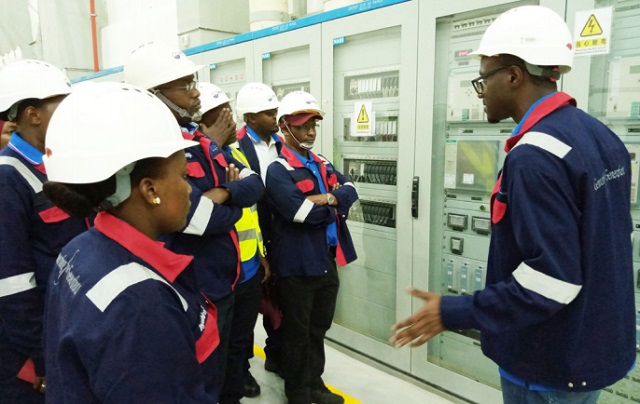
Isimba and Karuma power stations are expected to boost its earnings
Kampala, Uganda | JULIUS BUSINGE | Officials at Uganda Electricity Generation Company Limited (UEGCL) are hoping to record improved performance after posting the first net profit in 18 years.
The company reported at the end of last year that it had posted profit after tax of Shs24.7bn for FY2018/19 compared to a loss of Shs10.8bn a year before.
This development comes as the company’s income for the FY2018/19 came from two sources; concession income from Nalubaale Hydropower Electric Station (Shs5.2bn) and Isimba Shs49.4bn.
The electricity dispatched from Isimba hydropower dam alone was 320Gwh for the six months from January to June 2019.
The firm’s executives said, electricity sales from the 183MW Isimba and the 600MW Karuma hydropower dams as well as other lined up new electricity generation stations will put the firm on the profit growth trajectory.
Isimba dam was commissioned last year. Karuma dam, on the other hand, is expected to be commissioned this year.
Eng. Harrison Mutikanga, the chief executive officer at UEGCL said that their aim is to ensure that generation assets are run efficiently and their posterity is guaranteed.
“UEGCL can effectively finance or co-fund future generation assets,” he said.
This projected performance feeds into the company’s strategic plan (2018-2023), codenamed ‘Roadmap 1,300’ launched in December 2017.
The plan takes into account the aspirations of the government, key among which is the delivery of Isimba and Karuma hydropower dams as well as ensure operational efficiency of the Kiira/Nalubaale hydropower complex. Kiira/Nalubaale is operated by Eskom Uganda Limited whose parent company is South African power utility Eskom Holdings SOC Ltd.
The cardinal pillars of the roadmap are to ensure availability, reliability, affordability and the delivery of quality electricity to the consumers.
Eng. Proscovia Margret Njuki, the company’s Board chairperson said their focus for 2020 and beyond shall remain on operational efficiency, financial growth, stakeholder satisfaction and ensuring business process efficiency.
The other key element is increasing power generation capacity. Currently, the country’s electricity generation capacity stands at 1,177MW following the commissioning of Isimba hydropower dam last year. The peak system demand including exports to Kenya and Tanzania stands between 640-700MW, according to data from Electricity Regulatory Authority (ERA). Going forward, demand is expected to increase as new industries/manufacturing plants start operations in the various industrial parks.
Njuki said UEGCL will also commence the construction of the Muzizi (48MW) power station and continue with the implementation of Nyagak (6.6MW) hydropower projects.
The other plan is completion of the feasibility studies for the refurbishment of the Kiira/Nalubaale power stations, development of the small hydropower projects and the takeover and integration into the business of UEGCL the (50MW) Namanve Thermal Power Plant.
Meanwhile, Mutikanga said in 2020, UEGCL will concentrate its efforts on ensuring sustainability across its value chain, commencing with generation of power to its bottom line of financial sustainability.
He said that the key facets of sustainability will include adaptive strategies to climate change and catchment management given that hydropower is largely dependent upon adequate water flows.
The company will also work on feasibility studies for the three sites including Okulacere (6.3MW), Agbinika (2MW) and Maziba (1MW).
The company also plans to embark on its drive for an energy mix policy through implementation of a solar project and the takeover of the Namanve (50MW) thermo plant.
It will also consolidate its footprint in operation and maintenance of the Isimba facilities with an indigenous based workforce which is in line with the government’s vision 2040 and National Development Plan II and III.
Mutikanga said this will in part be achieved through enhanced operational efficiency and proficient asset management.
Evelyn Anite, the junior minister of finance in charge of privatization hailed the company’s performance for 2018/2019 and urged the top management to implement their business model with zero tolerance to corruption.
Performance figures for 2019 against 2018
- Net profit for the 12 months ended June 30, 2019 was Shs24.7bn against a loss of Shs10.8bn in 2018
- Total assets increased to Shs6.7trillion in FY2018/2019 from Shs5.6trillion a year before
- Concession fees reduced to Shs5.1bn in 2019 from Shs7.2bn in 2018
- Outstanding interest bearing debt increased from Shs4.7tn to Shs5.3tn
- Total number of employees grew from 163 to 186
****
 The Independent Uganda: You get the Truth we Pay the Price
The Independent Uganda: You get the Truth we Pay the Price



